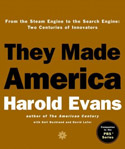Books |
They Made America From the Steam Engine to the Search Engine: Two Centuries of Innovation
Harold Evans
By
Published: Sep 15, 2010
Category:
Non Fiction
I’m very much interested in the story of the greatest economic growth of any nation in the history of the world. That story — the 200-year tale of practical innovation — has been told, in bits and pieces, in countless books. Now, in "They Made America," Harold Evans has told it in one: an oversized picture-and-text doorstop that’s so richly detailed, so excitingly told, that you have to consume it in small gulps. [To buy the hardcover book from Amazon, click here. For the overpriced paperback, click here. For the Kindle edition, click here.]
You don’t read this book in one sitting; you’d overdose on historical factoids and biographical detail. You drink it in sips because it tells you so much you didn’t know that it shatters your assumptions. And then it does something more — it makes you so ambitious to innovate and build that you’ll feel as if you’d downed a gallon of Red Bull.
Innovation, Evans reminds us, is hardly the same as invention. “Less than 10 percent of patents turn out to have commercial importance,” he notes. Which underscores the very practical, very American aspect of innovation — it is how fortunes were made. As the profiles of the mostly-male innovators document, those fortunes were deserved; these men worked insane hours and paid a high personal price for their achievements.
The subtitle (“from the steam engine to the search engine”) charts a curve so elegant and simple that you can dip into the book anywhere and know where you are. I’m not a heavy-lifting guy, so I cared a bit less than I might have about the steam engine, the cotton gin and the hand gun. I cared a great deal more about the sacrifices innovators made along the way — there’s a heartbreaking scene of an impoverished Charles Goodyear, unable to afford a funeral for his two-year-old son, carrying the dead boy’s body in a sheet to the cemetery. I was obsessed with the innovators’ view of money, and loved Samuel Colt’s line, “Money is trash I have always looked down on.” And I adored science reduced to imagery — did you know that the friction of steel wheels on steel rails makes a train 10 times more energy-efficient than a truck?
Where the book sings, for this reader, is in the big profiles of innovators whose stories you think you know. Like Thomas Edison, making 11th hour deals to get the money to keep his workshop going. Like the mother of the Wright Brothers, herself a gifted mathematician and inventor. Henry Ford — who died a bigot — was once a social reformer who raised his workers’ salaries to an unheard-of $5 a day because he had been deeply influenced by the writings of Ralph Waldo Emerson. And I took particular delight in the stories of lesser known men, like Juan Trippe, the compulsive exaggerator who created Pan American Airlines.
The modern era offers just as many surprises. Think you’re savvy about the Digital Age? How much do you know about Gary Kildall? Bio-tech? Are you up on the contributions of Herbert Boyer and Robert Swanson?
Evans ends the book with a short chapter: “Ten Lessons that can be learned from history’s innovators.” They seem obvious — but the obvious is, as this book amply illustrates, the hardest thing to see. Many didn’t perceive the possibilities in any of these inventions. A handful did. And it’s their unceasing focus on practical applications that makes this such a useful book for anyone contemplating entrepreneurship. It’s not, we learn here, about being first. It’s about staying in the garage, night after night, until the breakthrough comes.


